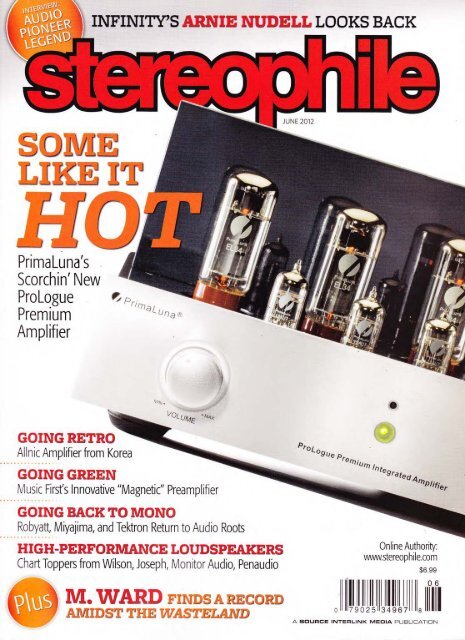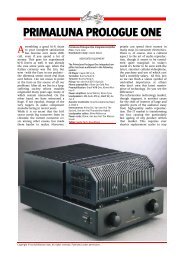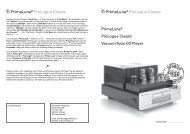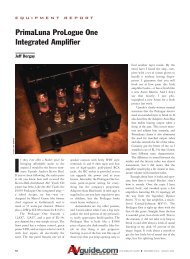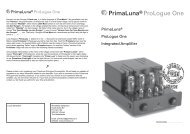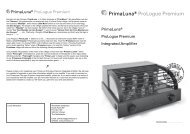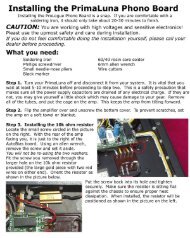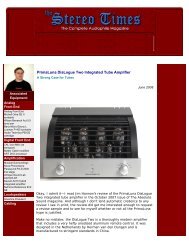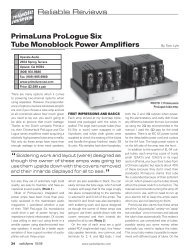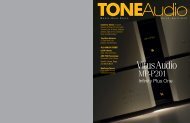Click here for the review. - PrimaLuna
Click here for the review. - PrimaLuna
Click here for the review. - PrimaLuna
Create successful ePaper yourself
Turn your PDF publications into a flip-book with our unique Google optimized e-Paper software.
EQUIPMENT REPORT<br />
ROBERT DEUTSCH<br />
PrimaL una ProLogue Pretniutn<br />
INTEGRATED AMPLIFIER<br />
'J Pri maluna*<br />
I<br />
megrared ampli£ers are hot. I don't mean in <strong>the</strong> literal<br />
sense-although having a preampli£er and stereo power<br />
arnpli£er in <strong>the</strong> same chassis usually results in higher<br />
running temperatures- but in <strong>the</strong> metaphorical one. Once<br />
\iewed as <strong>the</strong> rype of component that no serious audiophile<br />
woul consider buying, integrated amps have made a come-<br />
.· in popularity and prestige. Consider: <strong>the</strong> October 2006<br />
-Recommended Components" issue of Stereophile listed 29<br />
: regrated amps, w<strong>here</strong>as <strong>the</strong> October 2011 issue lists 40.<br />
· a.'Pizili!s 2010 Ampli£cation Component of <strong>the</strong> Year award<br />
went to an integrated amp, <strong>the</strong> Audio Research VSi60, beating<br />
out a host of heavy-hitter preamps and power amps. The 2012<br />
Stereophile Buyer's Guide lists 400 integrateds.<br />
What accounts <strong>for</strong> <strong>the</strong> renewed popularity of this product category?<br />
Cost is certainly a facto~ but it's not <strong>the</strong> only one. You could<br />
buy a separate preamp and power amp <strong>for</strong> <strong>the</strong> cost of some integrated<br />
amps. I suspect that a ~or patt of <strong>the</strong> appeal is <strong>the</strong> desire<br />
<strong>for</strong> simplicity: one box instead of two (o~ in <strong>the</strong> case of monoblock<br />
power amps, three) cluttering up <strong>the</strong> living/listening room,<br />
and fewer power cables and interconnects-ano<strong>the</strong>r cost saving.<br />
SPECIFICATIONS<br />
:•c< · ;:>'i0n Tubed, remotecontrolled,<br />
stereo integrated<br />
amplifier. Tube complement:<br />
four 12AU7, four EL34 or<br />
KT88. Inputs: 4 pairs RCA,<br />
1 pair HT bypass. Outputs:<br />
4 and 8 ohm trans<strong>for</strong>mer<br />
taps. Maximum output<br />
power: 35Wpc with EL34s<br />
(15.6dBW), 40Wpc with<br />
KT88s (15.9dBW). Frequency<br />
response: 20Hz-30kHz,<br />
± O.SdB. THD:
\\ben I consider <strong>the</strong> selection of produas <strong>for</strong> <strong>review</strong>, I don't<br />
co:m.alh· look <strong>for</strong> ones that are in <strong>the</strong> state-of-<strong>the</strong>-art, cost-<br />
;:: je~ category, but ra<strong>the</strong>r ones that promise to offer high<br />
- und quality at a moderate price. Based on my experience<br />
c.:;:h <strong>the</strong> PrirnaLuna ProLogue 1hree pre.amp and ProLogue<br />
~.-en power .amp (see December 2009, Vol.32 No.12), that<br />
?~cry much describes PrirnaLuna's design philosophy. So when<br />
: rea PrirnaLuna's announcement of <strong>the</strong> ProLogue Premium<br />
- .e best integrated .amp in its class j ust got better"- ! was keen<br />
, check it out.<br />
Description and design<br />
:r-said that an .amplification component's weight can tell you<br />
;. .or about its quality. O<strong>the</strong>r things being equal, amplifiers that<br />
-,.·eigh more tend to sound better. Two factors are involved<br />
::ere: trans<strong>for</strong>mers and chassis construction. Higher-capacity<br />
trans<strong>for</strong>mers weigh more and usually result in better sound.<br />
Having a more solid chassis helps suppress resonances, which<br />
negatively affect sound.<br />
For a 35Wpc integrated .amplifier, <strong>the</strong> ProLogue Premium is<br />
surprisingly heavy: 46.3 lbs. The chassis has a very solid feel, and<br />
<strong>the</strong> fit'n'finish is of a quality that suggests a much more expensive<br />
piece of equipment. The tubes are covered by a cage that can<br />
be easily lifted off ra<strong>the</strong>r than requiring a tool to remove it. The<br />
front panel has two knobs: one <strong>for</strong> volume, <strong>the</strong> o<strong>the</strong>r <strong>for</strong> source<br />
selection. T<strong>here</strong> is no balance control. Source selection has an<br />
unusual logic: no matter what source you've been listening to,<br />
when <strong>the</strong> ProLogue Premium is turned off and <strong>the</strong>n turned on<br />
ag.ain, <strong>the</strong> source defaults to CD. On <strong>the</strong> left side panel, near <strong>the</strong><br />
front, t<strong>here</strong>'s a rocker switch <strong>for</strong> power on/off; and on <strong>the</strong> right<br />
side ano<strong>the</strong>r rocker switch allows selection of bias optimized <strong>for</strong><br />
EL34 or KT88 power tubes. Accidentally setting this switch to<br />
;::·eophile .com • June 2012<br />
75
PRIMAlUNA PROLOGUE PREMIUM INTEGRATED AMPLIFIER<br />
a tube type not installed does no harm; in fact, <strong>the</strong> user manual<br />
suggests that you experiment with <strong>the</strong> switch position <strong>for</strong> personal<br />
taste. I explored matching/mismatching <strong>the</strong> tubes and bias<br />
switch positions, and preferred <strong>the</strong> matched positions.<br />
TI1e rear panel sports five pairs of RCA jacks <strong>for</strong> inputs,<br />
one pair labeled HT (<strong>for</strong> Home Theater). This is not just unity<br />
gain, but actually bypasses <strong>the</strong> preamp section, and allows<br />
volume to be controlled by a surround processor/receiver.<br />
The ProLogue Premium normally comes with EL34 output<br />
tubes, but can also accommodate KT88s, a set of which was<br />
included with <strong>the</strong> <strong>review</strong> sample. Except as noted, I did my<br />
listening with <strong>the</strong> EL34s. T<strong>here</strong> are connections <strong>for</strong> speakers<br />
with nominal impedances of 4 and 8 ohms. The ProLogue<br />
Premium is available with an internal moving-magnet phono<br />
stage ($199), but <strong>the</strong> <strong>review</strong> sample didn't include this option.<br />
The ProLogue Premium was designed in Holland by a team<br />
headed by H erman van den Dungen, and, like most audio<br />
products <strong>the</strong>se days, it's manufactured in China. According to<br />
Kevin Deal of Upscale Audio and <strong>PrimaLuna</strong> USA, <strong>PrimaLuna</strong>'s<br />
North American distributor, <strong>the</strong> engineering of <strong>the</strong> Premium<br />
began with a circuit design in which nothing was taken <strong>for</strong><br />
granted, and <strong>the</strong> components selected are of a quality not<br />
normally seen in cost-conscious designs. These include:<br />
• Nichicon and Solen polystyrene and tin-foil capacitors<br />
• Alps motorized potentiometer (said to be 10 times <strong>the</strong><br />
cost oflesser parts)<br />
• toroidal power trans<strong>for</strong>mer, manufactured in-house<br />
• capacitor-plus-choke power supply, designed to eliminate<br />
both low-frequency ripples and high-frequency hash<br />
• custom-designed output trans<strong>for</strong>mers, manufactured in-house<br />
• heavy-gauge, ventilated chassis with a five-coat flnish<br />
• construction by hand and point-to-point wiring<br />
The tubes supplied with <strong>the</strong> ProLogue Premium are Silver<br />
Label, according to Upscale Audio's classilication, and are said to<br />
be already "special" compared to standard tubes on <strong>the</strong> market.<br />
O<strong>the</strong>r tubes, including cryogenically treated ones, are available<br />
from Upscale.<br />
The ProLogue Premium has a number of specific, trademarked<br />
circuits designed to optimize per<strong>for</strong>mance and prevent<br />
damage to <strong>the</strong> amplifier in <strong>the</strong> event of a malfunction:<br />
• Adaptive AutoBias (AAB) monitors and adjusts bias constantly.<br />
AAB was present in previous <strong>PrimaLuna</strong> amplifiers,<br />
but <strong>the</strong> latest version is said to include more extended outputstage<br />
protection circuitry, to safeguard <strong>the</strong> output trans<strong>for</strong>mers,<br />
resistors, and high-voltage power supply in case a tube fails.<br />
• Bad Tube Indicator (BTl) is what <strong>PrimaLuna</strong> calls <strong>the</strong> red<br />
LED next to each output tube, though BTl is not quite what<br />
its name implies. A lit BTl LED indicates that <strong>the</strong> tube is<br />
drawing more power than it should; however, this condition may<br />
be only temporary, and not necessarily indicate a bad tube. If<br />
<strong>the</strong> BTl comes on, you're advised to turn off <strong>the</strong> ProLogue<br />
Premium, wait a few minutes, and turn it on again. If no BTl<br />
LEDs light up, you're fine. It's only when <strong>the</strong> indicator stays<br />
on that <strong>the</strong> cause is likely a bad tube, which must <strong>the</strong>n be replaced.<br />
During <strong>the</strong> <strong>review</strong> period, t<strong>here</strong> were a few instances<br />
of a BTl coming on, but each time, turning <strong>the</strong> amplifier off<br />
and <strong>the</strong>n on again fixed <strong>the</strong> problem.<br />
• Power Trans<strong>for</strong>mer Protection (PTP) is a <strong>the</strong>rmal switch<br />
built into <strong>the</strong> AC trans<strong>for</strong>mer. If <strong>the</strong> internal temperature<br />
gets too high, <strong>the</strong> AC is switched off automatically, coming<br />
back on again when <strong>the</strong> problem is resolved. This never<br />
happened during <strong>the</strong> <strong>review</strong> period.<br />
• Output Trans<strong>for</strong>mer Protection ( OTP) protects <strong>the</strong> output<br />
trans<strong>for</strong>mers from high-voltage transients. Power in my system<br />
is supplied by a PS Audio Perfect Wave Power Plant 5, which is<br />
designed to protect against transients of this sort; in any case, t<strong>here</strong><br />
were no problems in this area.<br />
• SoftStart is yet ano<strong>the</strong>r protection circuit, designed to<br />
To take <strong>the</strong>se measurements, I<br />
used Stereophile's loan sample<br />
of <strong>the</strong> top-of-<strong>the</strong>-line Audio<br />
Precision SYS2722 system (see<br />
t he January 2008 "As We See It," www.<br />
stereophile.com/asweseeit/108awsi/<br />
index.html, and www.ap.com). The unit<br />
shipped to me <strong>for</strong> measurement-serial<br />
no.10115729, a different sample from <strong>the</strong><br />
one auditioned by Robert Deutsch-was<br />
fitted with EL34 output tubes; I made<br />
sure t he bias switch on <strong>the</strong> amplifier's<br />
left side panel was set to <strong>the</strong> appropriate<br />
bias position <strong>for</strong> that tube.<br />
M aximum voltage gain into 8 ohms was<br />
on <strong>the</strong> low side <strong>for</strong> an integrated amplifier,<br />
at 36d B from <strong>the</strong> 8 ohm output trans<strong>for</strong>mer<br />
tap and 34dB from <strong>the</strong> 4 ohm tap,<br />
but this shouldn't be an issue with modern<br />
line-level source components. The Pro<br />
Logue Premium preserved absolute polarity<br />
and <strong>the</strong> input impedance was 35k ohms<br />
across <strong>the</strong> audioband, dropping to 30k<br />
ohms at 20kHz. Though <strong>the</strong>se figures are<br />
around half <strong>the</strong> specified 68k ohms, <strong>the</strong>y<br />
will result in no practical consequences.<br />
I assess an amplifier's output impedance<br />
by comparing <strong>the</strong> output voltages<br />
when it is loaded down with 8 and 4<br />
ohms with <strong>the</strong> voltage when it is loaded<br />
only by <strong>the</strong> Audio Precision's 100k ohms.<br />
Things went smoothly with <strong>the</strong> 4 ohm<br />
tap, which measured 1.7 ohms across <strong>the</strong><br />
audioband. However, when I tried to measure<br />
<strong>the</strong> impedance of <strong>the</strong> 8 ohm tap, <strong>the</strong><br />
~ .<br />
:~<br />
·• - - ~n<br />
10 20 50 100200 500 11
PRIMALUNA PROLOGUE PREMIUM INTEGRATED AMPLIFIER<br />
The tube cover has glass side panels.<br />
extend <strong>the</strong> life of sensitive components and reduce <strong>the</strong> chance<br />
of tube failure from <strong>the</strong>rmal shock.<br />
The basic design of <strong>the</strong> ProLogue Premium follows triedand-true<br />
principles: <strong>the</strong> output stage runs in Ultralinear mode,<br />
and tubes run well below <strong>the</strong>ir maximum ratings. Like o<strong>the</strong>r<br />
products in <strong>PrimaLuna</strong>'s Premium range, <strong>the</strong> ProLogue uses<br />
double 12AU7s in each channel ra<strong>the</strong>r than <strong>the</strong> earlier combination<br />
of 12AX7 and 12AU7. This is said to result in much<br />
lower distortion in <strong>the</strong> first stage.<br />
The ProLogue Premium includes a solidly built remote<br />
control that also controls <strong>the</strong> basic functions of<strong>PrimaLuna</strong><br />
CD players. I found <strong>the</strong> remote to work extremely well to<br />
set <strong>the</strong> desired volume: a very brief depression of <strong>the</strong> Up or<br />
Down button resulted in a correspondingly minimal change<br />
in volume, with no overshoot. Like most remotes, this one<br />
has buttons of identical shape and size. Since t<strong>here</strong> are only six<br />
buttons, remembering <strong>the</strong> most frequently used ones, Up/<br />
Down/Mute, is not that difficult, but I wish <strong>the</strong>y'd made <strong>the</strong><br />
Up and Down buttons differently shaped or sized from <strong>the</strong><br />
o<strong>the</strong>rs, so that <strong>the</strong>y could be identi£ed by touch.<br />
Setup<br />
Setting up an integrated amp like <strong>the</strong> ProLogue Premium<br />
should be pretty straight<strong>for</strong>ward: connect <strong>the</strong> source interconnects,<br />
speaker cables, and, last, <strong>the</strong> power cord; make sure<br />
<strong>the</strong> volume control is turned all <strong>the</strong> way down; turn it on.<br />
Sounds simple enough, but I ran into a problem at <strong>the</strong> very<br />
first stage: plugging in <strong>the</strong> interconnects from <strong>the</strong> CD player.<br />
The ProLogue Premium's RCA jacks have plastic covers on<br />
<strong>the</strong>m, and I had a difficult time trying to remove <strong>the</strong> ones over<br />
<strong>the</strong> CD input pair. (The user's manual makes no reference to<br />
<strong>the</strong>se protective covers; <strong>the</strong>y may have been a late addition.)<br />
Pulling on <strong>the</strong>m didn't seem to work, so I started twisting one<br />
of <strong>the</strong>m-and <strong>the</strong>n I felt it give, and <strong>the</strong> entire input jack started<br />
turning! Not good-I'd inadvertently broken <strong>the</strong> internal connection<br />
to <strong>the</strong> CD input jacks. To repair <strong>the</strong> damage, with Kevin<br />
Deal's approval, I engaged <strong>the</strong> services of a highly experienced<br />
audio technician, Roger Sherman, who carne to my home and<br />
was able to resolder <strong>the</strong> connection without difficulty. I eventually<br />
found out that t<strong>here</strong>'s a trick to removing <strong>the</strong> protective caps.<br />
T<strong>here</strong>'s a part that provides <strong>for</strong> a grip (it was facing <strong>the</strong> bottom,<br />
so I didn't see it); once you take hold of that, you can easily pull<br />
<strong>the</strong> cover off. This problem solved-and both channels of <strong>the</strong> CD<br />
input working properly-I was ready to do some listening.<br />
According to <strong>the</strong> folks who view measured electrical per<strong>for</strong>mance<br />
as <strong>the</strong> only criterion <strong>for</strong> <strong>the</strong> assessment of an amplifier,<br />
once an amplifier's internal components have reached operating<br />
temperature, <strong>the</strong> amplifier is per<strong>for</strong>ming as well as it's ever going<br />
to per<strong>for</strong>m: "break-in" and "warm-up" (beyond a minute or so)<br />
are simply myths.<br />
But most audiophiles and manufacturers of audiophile equipment<br />
know that break-in and warm-up phenomena are real,<br />
and that amplifiers vary in <strong>the</strong>se characteristics. In discussing <strong>the</strong><br />
effect of replacing tubes, <strong>PrimaLuna</strong> notes that "break-in yields<br />
improvements." In <strong>the</strong> case of <strong>the</strong> ProLogue Premium, I found<br />
that over a period of several weeks, with <strong>the</strong> amplifier ori 9-10<br />
The impedance of <strong>the</strong> 8 ohm tap<br />
appeared to be around 2 ohms, which<br />
gave rise to audible ±1.8dB variations in<br />
<strong>the</strong> amplifier's response when connected<br />
to our standard simulated loudspeaker<br />
(fig.1, gray trace). T<strong>here</strong> were some slight<br />
variations in response even into purely<br />
resistive loads, but more important, at <strong>the</strong><br />
200kHz upper limit of this graph can be<br />
seen a large resonant peak whose height<br />
and frequency increased with increasing<br />
load impedance. With <strong>the</strong> lOOk ohm input<br />
impedance of <strong>the</strong> Audio Precision test<br />
system, <strong>the</strong> amplifier became unstable<br />
and went into oscillation at <strong>the</strong> frequency<br />
of this peak. Th.is ultrasonic peak was<br />
better-damped from <strong>the</strong> 4 ohm tap (fig.2),<br />
when <strong>the</strong> variations in response with our<br />
simulated loudspeaker were a less-audible<br />
±1dB (gray trace). But <strong>the</strong> ultrasonic<br />
resonance resulted in<br />
and ringing with <strong>the</strong> Prima luna driving a<br />
10kHz squarewave into 8 ohms from <strong>the</strong> 8<br />
ohm tap (fig.3). Even from <strong>the</strong> 4 ohm tap,<br />
some overshoot can be seen with a 1kHz<br />
squarewave (fig.4), though <strong>the</strong> flat tops of<br />
this wave<strong>for</strong>m are a testament to <strong>the</strong> Pro<br />
Logue Premium's extended low frequencies.<br />
These four graphs were taken with<br />
<strong>the</strong> volume control set to its maximum.<br />
~ e~--~----1-~--+-~--+- 1<br />
><br />
"<br />
2<br />
~<br />
' 0<br />
I<br />
~<br />
1--<br />
-<br />
-<br />
r=<br />
r---1 -<br />
+DE<br />
[<br />
-20 b<br />
-
PRIMALUNA PROLOGUE PREMIUM INTEGRATED AMPLIF IER<br />
hours a day and playing music 3-4 hours a day (I leave <strong>the</strong> CD<br />
player on all <strong>the</strong> rime), t<strong>here</strong> was an improvement: <strong>the</strong> music<br />
sounded more detailed, and somehow more "relaxed" and freeflowing.<br />
It also seem ed to m e that, playing music each day <strong>for</strong><br />
several hours, t<strong>here</strong> was a similar sonic improvement, suggesting<br />
a warm-up effect beyond <strong>the</strong> few minutes it takes <strong>the</strong> tubes to<br />
reach <strong>the</strong>ir normal operating temperature. I noted <strong>the</strong>se effects<br />
while using <strong>the</strong> Avantgarde Uno Nano speakers; <strong>the</strong> warm-up<br />
effect was also apparent with <strong>the</strong> GoldenEar Triton Twos. I<br />
decided to evaluate it in a more systematic way.<br />
First, with <strong>the</strong> GoldenEar Triton Twos in <strong>the</strong> system , I turned<br />
on <strong>the</strong> ProLogue Premium, waited five minutes, and played track<br />
3 of <strong>the</strong> Chesky Records Jazz Sampler & Audiophile Test OJmpad<br />
D isc, vol.t ( Chesky JD37). I listened carefully, noting all <strong>the</strong> little<br />
sonic details, stopped <strong>the</strong> CD, and lefi: <strong>the</strong> room <strong>for</strong> an hour. I<br />
<strong>the</strong>n went back to <strong>the</strong> listening room- w<strong>here</strong> <strong>the</strong> system had<br />
been on all this rime, but without playing music-and listened to<br />
<strong>the</strong> same track again. (The volume control was not touched.) My<br />
conclusion- which those who want double-blind controls are free<br />
co ignore-was that t<strong>here</strong> was indeed an improvement, and of <strong>the</strong><br />
son that I'd previously noted more in<strong>for</strong>mally. What I thought<br />
\Yas interesting was that <strong>the</strong> improvement did not depend on <strong>the</strong><br />
speakers playing during <strong>the</strong> warm-up period. It's possible that<br />
playing <strong>the</strong> speakers would result in a fur<strong>the</strong>r improvement in<br />
<strong>the</strong> sound, but it would require some additional comparisons to<br />
determine if this is <strong>the</strong> case.<br />
Sound: Take One<br />
I used <strong>the</strong> ProLogue Premium with three speakers: my reference<br />
Avantgarde Acoustic Uno Nanos (<strong>review</strong>ed in July 2009),<br />
<strong>the</strong> GoldenEar Triton Twos (February 2012), and, briefly, <strong>the</strong><br />
M arti.nLogan Monti.ses (soon to be <strong>review</strong>ed). These speakers<br />
represent a wide range of design approaches, and sound quite<br />
different from each o<strong>the</strong>r.<br />
First up were <strong>the</strong> Avantgardes. With <strong>the</strong>se speakers, I always<br />
experience a degree of trepidation when I turn on <strong>the</strong> system<br />
afi:er installing a new amplifier. Never mind any subtleties of<br />
sound quality- is t<strong>here</strong> noise (hum or buzz) at a level that's<br />
likely to interfere with my e1~oyment of <strong>the</strong> music? Whatever<br />
noise t<strong>here</strong> is at <strong>the</strong> output of <strong>the</strong><br />
amplifier, <strong>the</strong> Avantgardes, with<br />
<strong>the</strong>ir + 1 OOdB sensitivity, will let<br />
m e hear it. I can try to "listen past<br />
<strong>the</strong> noise," but I don't like having<br />
to do so. With <strong>the</strong> last amplifier<br />
I <strong>review</strong>ed, <strong>the</strong> o<strong>the</strong>rwise admirable<br />
Conrad-Johnson LP125M<br />
(December 2011), I had to go to<br />
all kinds of trouble-grounding/<br />
ungrounding different parts of <strong>the</strong><br />
system and dressing <strong>the</strong> interconnects-be<strong>for</strong>e<br />
<strong>the</strong> noise abated to<br />
<strong>the</strong> point w<strong>here</strong> it was negligible.<br />
Turning on <strong>the</strong> system with <strong>the</strong><br />
ProLogue-Avantgarde combination<br />
<strong>for</strong> <strong>the</strong> first rime, I was much<br />
relieved to find it dead quiet. With<br />
<strong>the</strong> volume turned way up but<br />
no music playing, no sound carne<br />
Most<br />
audiophiles and<br />
manufacturers<br />
of audiophile<br />
equipment<br />
know that<br />
break-in<br />
and warm-up<br />
phenomena<br />
are real, and<br />
that amplifiers<br />
vary in <strong>the</strong>se<br />
characteristics.<br />
from <strong>the</strong> speakers; it was as if <strong>the</strong> system were not on at all. Very<br />
impressive-and it boded well <strong>for</strong> <strong>the</strong> rime I was about to spend<br />
with <strong>the</strong> ProLogue. The Avantgardes are known to present a<br />
high-impedance load, so I connected <strong>the</strong>m to <strong>the</strong> Premium's 8<br />
ohm tap s; a brief comparison using <strong>the</strong> 4 ohm taps showed only<br />
a marginal difference, one in favor of <strong>the</strong> 8 ohm connection.<br />
The preamp and power amp that I've found to work most<br />
optimally with <strong>the</strong> Ava.ntgarde Uno Nanos are Convergent<br />
Audio Technology's SL-1 Renaissance and Audiopax's Model88<br />
measurements, continued<br />
Commendably, <strong>here</strong> was no change in <strong>the</strong><br />
response · <strong>the</strong> volume control set to<br />
ter positions and <strong>the</strong> channel balance<br />
excellent<br />
el separation (not shown)<br />
, a > 70dB in both direction<br />
z, but just SO dB at 20kHz. I<br />
--'E£ a 1 possible ways of connecting<br />
·-e gro nd of <strong>the</strong> Prima luna ampli·<br />
"e :o hat of <strong>the</strong> Audio Precision test<br />
, including running a separate<br />
.-•e om <strong>the</strong> Prologue Premium's<br />
grounding post on its rear terminal to<br />
<strong>the</strong> AP's chassis, but whatever I tried,<br />
<strong>the</strong> wideband, unweighted signal/noise<br />
ratio, taken with <strong>the</strong> input shorted and <strong>the</strong><br />
volume control at its maximum and ref.<br />
lW into 8 ohms from <strong>the</strong> 8 ohm tap, was<br />
a disappointing 57.3dB in <strong>the</strong> left channel,<br />
63.1dB in <strong>the</strong> right. As shown by fig.S, this<br />
was because some low-level hum was<br />
present at <strong>the</strong> AC supply frequency and<br />
its harmonics. Switching an A-weighting<br />
filter into circuit improved <strong>the</strong> measured<br />
ratios to 76.8 and 77.7dB, left/right,<br />
respectively, which gives a closer estima·<br />
tion of <strong>the</strong> audibility of this noise. Even so,<br />
I note that RD had no noise problems with<br />
his sensitive Avantgarde horn speakers,<br />
so perhaps his sample of <strong>the</strong> Prologue<br />
Premium was quieter than mine. What I<br />
did find with my sample was that it was<br />
mildly microphonic. If I banged <strong>the</strong> top<br />
of <strong>the</strong> trans<strong>for</strong>mer cover-even with <strong>the</strong><br />
input shorted-I could generate a ringing<br />
tone with a frequency of around 250Hz<br />
10 10<br />
% %<br />
0.5 0.5<br />
0.2 02 - ~-<br />
0 1<br />
100m200m 500m 1<br />
01<br />
100m200m SOOm 1 5 10 20 50 100<br />
5 10 20 50 100<br />
~=--~ 500m 1 2 5 10 20 50100<br />
w w w<br />
----------------------------~<br />
~""-..tuna Prologue Premium, 8 ohm tap, distor- Fig.7 Primaluna Prologue Premium, 4 ohm tap, distor- Fig.S Primaluna Prologue Premium, 4 ohm tap, distor-<br />
;s·
PRIMALUNA PROLOGUE PREMIUM INTEGRATED AMPLI FIER<br />
Mk.II. The 30Wpc of <strong>the</strong> Audiopax is more than enough to run<br />
<strong>the</strong> Avantgardes to high levels, and <strong>the</strong> combination provides a<br />
near-ideal mix of timbral accuracy, detail, and dynamics. Changing<br />
from <strong>the</strong> CAT-Audiopax to <strong>the</strong> ProLogue Premium might<br />
be expected to have produced a sense of disappointment, but<br />
my feeling was one of excitement: this integrated amp, costing<br />
a mere fraction of <strong>the</strong> CAT-Audiopax combo ($32,000 with <strong>the</strong><br />
Turning on<br />
<strong>the</strong> system<br />
with <strong>the</strong><br />
ProLogue<br />
Avantgarde<br />
combination<br />
<strong>for</strong> <strong>the</strong><br />
first time,<br />
I was much<br />
relieved<br />
to find it<br />
dead quiet.<br />
latter in its current, Mk.III <strong>for</strong>m), was<br />
able to produce sound that was faithful<br />
to <strong>the</strong> source, musically involving, and<br />
altoge<strong>the</strong>r very listenable. Like o<strong>the</strong>r<br />
tube preampli£ers and ampli£ers that<br />
I have experience with, <strong>the</strong> ProLogue<br />
Premium had a special way with<br />
voices, reproducing <strong>the</strong>m in a way that<br />
had a more "human" quality than with<br />
even topnotch solid-state products like<br />
<strong>the</strong> Simaudio Moon Evolution W-7<br />
power ampli£er.<br />
Listening more ctitically, comparing<br />
<strong>the</strong> ProLogue Premium with <strong>the</strong><br />
CAT-Audiopax at matched levels, I<br />
heard some differences. With <strong>the</strong> CAT<br />
Audiopax, <strong>the</strong> sound was more convincingly<br />
three-dimensional, with more<br />
"air" around voices and instruments; <strong>the</strong><br />
highs were more detailed without becoming overly bright; and it<br />
was easier to follow <strong>the</strong> music's subtle ebb and flow. These differences-apparent<br />
when I was wearing my "sharpener'' hat-are to<br />
be expected, given <strong>the</strong> price difference. People who have $18,000<br />
to spend on speakers like <strong>the</strong> Avantgarde Uno Nanos can usually<br />
af<strong>for</strong>d to spend more than $2299 on an integrated amp, and<br />
probably should, to get <strong>the</strong> most from <strong>the</strong>ir speakers. Howeve~; if<br />
you've picked up a used pair ofUno Nanos (or Unos or Duos)<br />
at a bargain price and don't have a lot of money left ove~; <strong>the</strong><br />
ProLogue Premium would give you maybe 900fo of what <strong>the</strong>se<br />
speakers are capable of-and outside of an AlB comparison, you<br />
wouldn't know what you were missing.<br />
Sound: In <strong>the</strong> Real World<br />
The Avantgarde Uno Nano is a rare bird: ultra-high efficiency,<br />
horn-loaded midrange and tweeter, powered subwoofer.<br />
Evaluating an amplifier with this speaker, while useful, doesn't<br />
tell you how <strong>the</strong> amp will fare with more conventional speakers-and,<br />
of course, t<strong>here</strong>'s a major mismatch in price. Keeping<br />
<strong>the</strong>se factors in mind, I spent most of my ProLogue Premium<br />
<strong>review</strong>ing time using speakers that are less exotic in design and<br />
provide a better price match: <strong>the</strong> GoldenEar Triton Twos.<br />
The Triton Two is one of my favorite speakers: a floorstanding<br />
three-way that sells <strong>for</strong> $2999/paii; whose sound quality<br />
com<strong>for</strong>tably exceeds what is normally expected at this price level.<br />
Like <strong>the</strong> Uno Nano, <strong>the</strong> Triton Two incorporates a powered<br />
subwoofer. Its claimed sensitivity, confmned by John Atkinson's<br />
measurements, is 91dB--somewhat higher than <strong>the</strong> norm, but<br />
much lower than <strong>the</strong> Uno Nano's. JA also noted that "<strong>the</strong> speaker<br />
will not be too difficult <strong>for</strong> <strong>the</strong> partnering ampli£er to drive."<br />
The combination of <strong>the</strong> Triton Twos and <strong>the</strong> ProLogue Premium<br />
proved particularly synergistic- it was as if each designer<br />
had used <strong>the</strong> o<strong>the</strong>r's speaker to fine-tune <strong>the</strong> sound of his own.<br />
The speakers sounded good through <strong>the</strong> ProLogue Premium's<br />
8 ohm connectors, and even better-more dynamic, more "present''-through<br />
<strong>the</strong> 4 ohm taps.<br />
Comparing <strong>the</strong> ProLogue Premium to <strong>the</strong> Audiopax 88<br />
Mk.II and <strong>the</strong> Simaudio W-7, each driven by <strong>the</strong> CAT SL-1<br />
Renaissance preamp, t<strong>here</strong> were areas of per<strong>for</strong>mance in<br />
which each of <strong>the</strong>se high-end references sounded superior.<br />
The Audiopax's m;yor area of superiority was its ability to<br />
present recordings that normally sound a bit harsh in a way<br />
and a level of 30mV RMS. I doubt that<br />
this will be a problem in normal use.<br />
With <strong>the</strong> amplifier's output trans<strong>for</strong>mer<br />
tap matched to <strong>the</strong> load, <strong>the</strong><br />
Prima luna Prologue Premium just met<br />
its specified power of 35Wpc (15.6dBW).<br />
Fig.6 shows how <strong>the</strong> THD+noise percentage<br />
present in <strong>the</strong> 8 ohm output changes<br />
with power into 8 ohms. The THD+N<br />
reaches 1%, our standard definition of<br />
clipping, at 35Wpc. Figs. 7 and 8 show<br />
how <strong>the</strong> THD+N percentage changes<br />
with <strong>the</strong> 4 ohm tap driving 8 and 4 ohms,<br />
respectively. The Prologue Premium<br />
clips at 21Wpc into 8 ohms (13.2dBW)<br />
and 32W into 4 ohms (12dBW), but <strong>the</strong><br />
amplifier does meet its specified power<br />
from this tap at 1.4% THO. I haven't<br />
shown <strong>the</strong> clipping behavior into 2 ohms<br />
from ei<strong>the</strong>r tap, as <strong>the</strong> amplifier switched<br />
itself off and lit one or more BTl LEOs as<br />
<strong>the</strong> power reached 40Wpc into this load.<br />
As figs. 6-8 make clear, <strong>the</strong> Prologue<br />
Premium is not a low-distortion design.<br />
I plotted how its THD+N percentage<br />
changes with frequency at 4.8V, a level<br />
equivalent to 2.9W into 8 ohms, w<strong>here</strong><br />
I could be sure that <strong>the</strong> distortion was<br />
higher than <strong>the</strong> noise floor. The results<br />
are shown in figs. 9 (8 ohm tap) and 10<br />
(4 ohm tap). The amplifier is more linear<br />
from its 4 ohm tap, but t<strong>here</strong> are significant<br />
rises in distortion at <strong>the</strong> frequency<br />
·o<br />
T - ·~ +~<br />
:~r<br />
: : ~FWf + i7<br />
.. ,<br />
20 50 100 200 500 1k 2k. Sk 10k20k<br />
"'<br />
Fig.9 Prima luna Prologue Premium, 8 ohm tap,<br />
THD+N (%) vs frequency at 4.8V into: 8 ohms (left<br />
channel blue, right red), 4 ohms (left cyan, right<br />
magenta), 2 ohms (gray).<br />
%<br />
Fig.lO Prima luna Prologue Premium, 4 ohm tap,<br />
THD+N (%) vs frequency at 4.8V into: 8 ohms (left<br />
channel blue, right red), 4 ohms (left cyan, right<br />
magenta), 2 ohms (gray).<br />
Time in ms<br />
Fig.ll Prima luna Prologue Premium, 4 ohm tap,<br />
1kHz wave<strong>for</strong>m at lW into 4 ohms (top), 0 .104%<br />
THD+N; distortion and noise wave<strong>for</strong>m with<br />
fundamental notched out (bottom, not to scale).<br />
;:ereophile.com • June 2012<br />
83
PRIMALUNA PROLOGUE PREMIUM INTEGRATED AMPLIFIER<br />
that made me think that <strong>the</strong> recording sounded better than<br />
I'd realized. Come Fly With Me (CD, Capitol CDP 7 48469 2)<br />
catches Frank Sinatra at his confident best, with Billy May's<br />
arrangements and musical direction providing perfect support,<br />
but t<strong>here</strong>'s no getting around <strong>the</strong> fact that <strong>the</strong> massed strings<br />
have a certain edge, whe<strong>the</strong>r from limitations of <strong>the</strong> 1957<br />
recording technology or <strong>the</strong> digital transfer. Tbis edge was less<br />
noticeable through <strong>the</strong> CAT-Audiopax combo than through<br />
<strong>the</strong> ProLogue Premium.<br />
The Moon W-7 had more of this edge than <strong>the</strong> ProLogue<br />
Premium-and much more than <strong>the</strong> Audiopax-but it beat<br />
both tubed amps in its sense of power and dynamics, had<br />
more extended bass, and was able to drive <strong>the</strong> speakers to a<br />
higher level without strain. The sonic character of <strong>the</strong> Pro<br />
Logue Premium was in between <strong>the</strong> Audiopax and <strong>the</strong> Moon<br />
W-7. At times, listening to <strong>the</strong> system with <strong>the</strong> Audiopax in it,<br />
I thought, Yes, this is <strong>the</strong> way it's supposed to sound-and <strong>the</strong>n I began<br />
to get <strong>the</strong> feeling that <strong>the</strong> sound was too smooth, too liquid.<br />
Similarly, when listening to <strong>the</strong> system through <strong>the</strong> Moon<br />
W-7, I was impressed with <strong>the</strong> clarity, definition, and dynamic<br />
swing-Yes, this is more like <strong>the</strong> real thing. Then my critical<br />
self again reared its head, and I began to feel that <strong>the</strong> sound<br />
was a bit on <strong>the</strong> aggressive side, pushing <strong>the</strong> music toward me<br />
ra<strong>the</strong>r than drawing me into it. And whenever I switched over<br />
to <strong>the</strong> ProLogue Premium, I had <strong>the</strong> feeling that <strong>here</strong> was an<br />
amplifier-speaker combination that just "clicked." For an integrated<br />
amplifier that costs a mere fraction of <strong>the</strong>se high-end<br />
references, this is remarkable per<strong>for</strong>mance.<br />
The ProLogue Premium's Home Theater input bypasses<br />
<strong>the</strong> preamp section, including <strong>the</strong> volume control. I did a trial<br />
using this input, connecting it to <strong>the</strong> output of <strong>the</strong> CAT preamp,<br />
with <strong>the</strong> Ayre Acoustics CX-7eMP CD player connected<br />
to <strong>the</strong> CAT preamp's input. In this setup-in which I used <strong>the</strong><br />
ProLogue Premium as only a power arnp- I could evaluate <strong>the</strong><br />
contribution of <strong>the</strong> ProLogue's preamp section to <strong>the</strong> sound.<br />
When I compared <strong>the</strong> ProLogue Premium with <strong>the</strong> CDplayer<br />
interconnects plugged directly into its CD inputs vs<br />
into one of <strong>the</strong> CATs line-level inputs, <strong>the</strong> output of <strong>the</strong><br />
CAT driving <strong>the</strong> ProLogue's amp section directly, <strong>the</strong> differences<br />
were not great but were significant. The tonal balance<br />
remained much <strong>the</strong> same, but with <strong>the</strong> CAT doing <strong>the</strong><br />
preamplification t<strong>here</strong> was a definite improvement in what I<br />
might call finesse-<strong>the</strong> percussion instruments in track 3 of <strong>the</strong><br />
Chesky test CD were clearer and more distinct, but also more<br />
delicate, and with no added edge or harshness. Double-bass<br />
notes were also more clearly defined. Bass drums had greater<br />
weight. Given that <strong>the</strong> CAT SL-1 Renaissance is widely recognized<br />
as one of <strong>the</strong> world's best preamps, and costs nearly<br />
four times as much as <strong>the</strong> ProLogue, <strong>the</strong> fact that it sounded<br />
better than <strong>the</strong> Premium's preamp section shouldn't come as a<br />
surprise. The real surprise is how close <strong>the</strong> ProLogue's preamp<br />
section carne to <strong>the</strong> sound of <strong>the</strong> reference-quality CAT SL-1.<br />
into impedances.<br />
This amplifier really does need to be used<br />
with speakers with <strong>the</strong> same nominal imp.edance<br />
as <strong>the</strong> trans<strong>for</strong>mer tap or higher.<br />
Fortunately, at low powers into high<br />
impedances, <strong>the</strong> distortion is strongly<br />
second-harmonic in nature (fig.ll),<br />
which is relatively innocuous. At higher<br />
output currents, <strong>the</strong> third starts to<br />
develop (fig.12), and even at moderate<br />
powers at low frequencies, a regular<br />
picket fence of higher-order harmonics<br />
appears (fig.13); At <strong>the</strong> o<strong>the</strong>r eQd of<br />
<strong>the</strong> spectrum, despite <strong>the</strong>amplifier's<br />
decreasing linearity at high frequencies,<br />
<strong>the</strong> Prima luna did quite well on<br />
<strong>the</strong> high;:frequency intermodulation<br />
test. At a level about 3dB below visible<br />
wave<strong>for</strong>m clipping on an oscilloscope,<br />
·<strong>the</strong> second-order difference product at<br />
1kHz resulting from an equal mix of 19<br />
and 20kHz tones was at -56dB (0.15%),<br />
with <strong>the</strong> n11zner·-or·aer<br />
21kHz lying at -60dB (0.1%) (fig.14).<br />
Primaluna's Prologue Premium measures<br />
about as well as I expect from a classic<br />
tube design that uses a push-pull pair<br />
of El34 output tubes. Both <strong>the</strong> hum and<br />
<strong>the</strong> amplifier's instability when unloaded<br />
probably stem from <strong>the</strong> compromises<br />
necessary to manufacture a trans<strong>for</strong>mercoupled<br />
amplifier of this sort that sells <strong>for</strong><br />
a relativelyaf<strong>for</strong>dable price.-JohnAtlcinson<br />
-20<br />
-40<br />
-60<br />
-80<br />
-100<br />
Fig.12 Primaluna Prologue Premium, 8 ohm tap,<br />
1kHz wave<strong>for</strong>m at 2W into 4 ohms (top), 0.584%<br />
THD+N; distortion and noise wave<strong>for</strong>m with fundamental<br />
notched out (bottom, not to scale).<br />
Fig.13 Primaluna Prologue Premium, 4 ohm tap,<br />
spectrum of 50Hz sinewave, DC-1kHz, at 10W<br />
into 8 o~ms (left channel blue, right red; linear<br />
frequency scale).<br />
"'<br />
Fig.14 Primal una Prologue Premium, 4 ohm<br />
tap, HF intermodulation spectrum, DC-24kHz,<br />
19+ 20kHz at 13W peak into 8 ohms (left channel<br />
blue, right red; linear frequency scale),<br />
10k<br />
15k<br />
stereophile.com • June 2012<br />
85
PRIMALUNA PROLOGUE PREMIUM INTEGRATED AMPLIFIER<br />
connectors, <strong>the</strong> combination of ProLogue Premium and MartinLogan<br />
Montis became a more-than-credible match, despite<br />
<strong>the</strong> m~or disparity in <strong>the</strong>ir prices.<br />
The EL34 output tubes can be replaced with KT88s.<br />
Sound: More Exotica<br />
As I neared <strong>the</strong> end of my time with <strong>the</strong> ProLogue Premium,<br />
a pair of MartinLogan Montis speakers arrived <strong>for</strong> <strong>review</strong>.<br />
The Montis ($10,000/pair) features an electrostatic midrange/<br />
tweeter mated to a powered woofer. Electrostatics are notorious<br />
<strong>for</strong> presenting a difficult load to amplifiers (<strong>the</strong> specifications<br />
<strong>for</strong> <strong>the</strong> Montis state that its impedance at 20kHz drops to 0.52<br />
ohm), but having a woofer with its own amplifier should help.<br />
Since <strong>the</strong> ProLogue Premium was <strong>the</strong> first amplifier I used<br />
with <strong>the</strong> Montis, I had no background to draw on to determine<br />
if, in fact, <strong>the</strong> ProLogue was a good match <strong>for</strong> this speaker,<br />
but it sounded pretty good to me. Mark Aling of Paradigm!<br />
MartinLogan, who helped me set up <strong>the</strong> Mantises, and who<br />
has heard <strong>the</strong>m in o<strong>the</strong>r contexts, indicated that he was pleased<br />
with <strong>the</strong> sound. Whatever <strong>the</strong> effect of <strong>the</strong> low-impedance<br />
load in <strong>the</strong> high treble, <strong>the</strong> ProLogue Premium didn't seem<br />
fazed by it- perhaps because t<strong>here</strong>'s so little musical content up<br />
t<strong>here</strong>. A test with <strong>the</strong> CAT-Audiopax quickly revealed that this<br />
was not a good combination: <strong>the</strong> treble was much softer than<br />
ideal, and <strong>the</strong> amp ran out of steam at higher-but not roomshaking-<br />
levels. The ProLogue Premium fared better; <strong>the</strong> highs<br />
were still a bit subdued, but to a lesser extent.<br />
As mentioned earlier in <strong>the</strong> <strong>review</strong>, my listening throughout<br />
was with <strong>the</strong> EL34 output tubes. When I had <strong>the</strong> GoldenEar<br />
Triton Twos in <strong>the</strong> system, I did a brief trial using <strong>the</strong> KT88s,<br />
and I much preferred <strong>the</strong> EL34s' more laid-back sound. The<br />
ProLogue Premium's rated output using <strong>the</strong> EL34s is 35Wpc,<br />
w<strong>here</strong>as with <strong>the</strong> KT88s it's 40Wpc-a difference small enough<br />
that I thought it would be inconsequential. Never<strong>the</strong>less, I<br />
swapped out <strong>the</strong> EL34s <strong>for</strong> KT88s (remembering to change <strong>the</strong><br />
position of <strong>the</strong> bias switch), and, whe<strong>the</strong>r because of <strong>the</strong> minor<br />
power difference or o<strong>the</strong>r reasons, I preferred <strong>the</strong> sound with <strong>the</strong><br />
KT88s. Unlike with <strong>the</strong> Triton Two, w<strong>here</strong> <strong>the</strong> sound with <strong>the</strong><br />
KT88s was a bit on <strong>the</strong> brash side, with <strong>the</strong> Montis <strong>the</strong> sound<br />
was tonally better balanced than with <strong>the</strong> EL34s, with more<br />
extended highs and a more dynamically lively presentation.<br />
My last comparison involving <strong>the</strong> Montis and <strong>the</strong> KT88-<br />
equipped ProLogue Premium involved changing from <strong>the</strong> 4<br />
ohm to <strong>the</strong> 8 ohm speaker connectors. The Montis is rated at<br />
4 ohms, but is described as being "compatible with 4, 6, or 8<br />
ohm rated amplifiers." I fully expected that <strong>the</strong> 4 ohm output<br />
would produce better results, as it had with <strong>the</strong> Triton Two.<br />
Not so! The sound using <strong>the</strong> 8 ohm connectors was more<br />
open and better focused.<br />
It just goes to show you that in audio t<strong>here</strong>'s little that you<br />
can take <strong>for</strong> granted. With <strong>the</strong> KT88s and <strong>the</strong> 8 ohm speaker<br />
Conclusions and System Building<br />
Built to a high standard, <strong>the</strong> <strong>PrimaLuna</strong> ProLogue Premium<br />
offers outstanding sound quality at a very reasonable price.<br />
In my listening tests, it combined well with speakers both<br />
conventional and exotic, and gave high-end references more<br />
than a run <strong>for</strong> <strong>the</strong>ir money.<br />
Audiophiles often complain about how expensive this hobby<br />
has become-and not without justification. In apportioning<br />
<strong>the</strong> job of reporting on amplification components at <strong>the</strong> 2012<br />
Consumer Electronics Show, Larry Greenhill and Stephen<br />
Mejias set $5000 as <strong>the</strong> dividing line between "inexpensive"<br />
and "expensive." (Stephen tells me that he would have liked<br />
to set <strong>the</strong> cutoff at $1000, but t<strong>here</strong> simply wasn't enough at<br />
CES below that price, which would have led to an unequal<br />
division oflabor.J The 2012 Stereophile Buyer's Guide lists 29<br />
integrated amps costing $10,000 or more, including one that<br />
comes in at a cool $100,000. Is this sheer madness?<br />
What tends to be <strong>for</strong>gotten during <strong>the</strong> expressions of outrage<br />
about high prices is that if you ignore equipment at "crazy<br />
prices" -and, of course, each of us has his or her own idea of<br />
exactly w<strong>here</strong> "craziness" begins-ours is a great age <strong>for</strong> <strong>the</strong> costconscious<br />
audiophile. If you do your<br />
homework on what's available, read<br />
<strong>the</strong> <strong>review</strong>s, and visit dealers who<br />
make a point of offering <strong>the</strong>ir customers<br />
value, you can assemble a system<br />
<strong>for</strong> a reasonable price that- with attention<br />
paid to component matching and<br />
setup-can offer sound quality that<br />
comes close to <strong>the</strong> cost-no-object.<br />
The ProLogue Premium would be<br />
an excellent component around which<br />
to start assembling such a system. I<br />
found it combined well with speakers<br />
as disparate as <strong>the</strong> Avantgarde Uno<br />
Nano, GoldenEar Triton Two, and<br />
MartinLogan Montis. The ProLogue<br />
The<br />
PrimaL una<br />
ProLogue<br />
Premium<br />
offers<br />
outstanding<br />
sound quality<br />
at avery<br />
reasonable<br />
price.<br />
Premium also allows some fine-tuning to match <strong>the</strong> speakers:<br />
t<strong>here</strong>'s a choice of output tenninals (8 or 4 ohms), switchable<br />
power-tube bias, and a choice of power tubes (EL34 or KT88).<br />
Playing <strong>the</strong> system-building game, first with an emphasis<br />
on keeping <strong>the</strong> total system price down, I would combine <strong>the</strong><br />
ProLogue Premium ($2299) with <strong>the</strong> Marantz CD5004 CD<br />
player ($350), and with something like <strong>the</strong> Dynaudio Excite<br />
X12 ($1200/pair) or PSB Imagine B ($1100/pair) speakers,<br />
plus some entry-level cables from AudioQuest or Kimber<br />
Kable. At a total price of around $4000-plus ano<strong>the</strong>r $400 <strong>for</strong><br />
a Pro-Ject Debut III turntable and $199 <strong>for</strong> <strong>the</strong> <strong>PrimaLuna</strong><br />
phono stage to get you into <strong>the</strong> world of vinyl- you'd have a<br />
musically satisfying system that represents outstanding value.<br />
At <strong>the</strong> next system price level, <strong>the</strong> obvious partnering<br />
loudspeaker <strong>for</strong> <strong>the</strong> ProLogue Premium is <strong>the</strong> GoldenEar<br />
Triton Two. Keeping everything else <strong>the</strong> same, you'd have<br />
a system price of about $6000. Fur<strong>the</strong>r improvements could<br />
come from upgrading <strong>the</strong> digital source (I'd first check out<br />
Oppo's BDP-95 SA CD/CD player, <strong>for</strong> $1000)-and consider<br />
getting better cables and a power-line conditioner. For a total<br />
price well under $8000, this system could easily compete<br />
with <strong>the</strong> typical rig costing $20,000.<br />
Yes, this is a great time to be an audiophile. •<br />
stereophile.com • June 2012<br />
87


